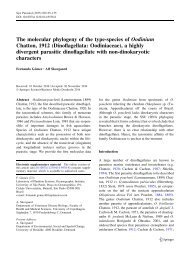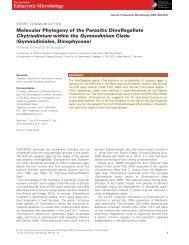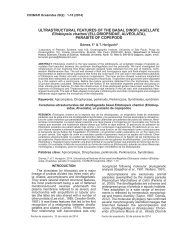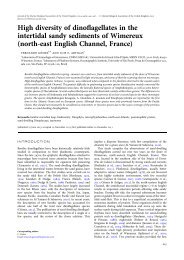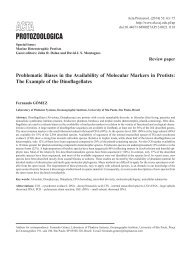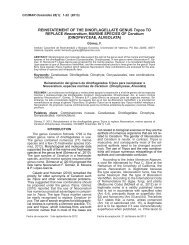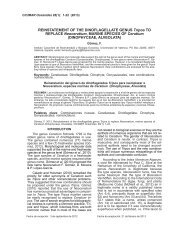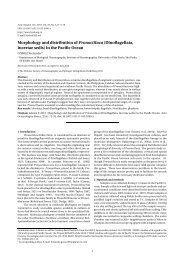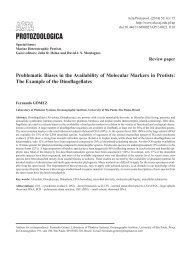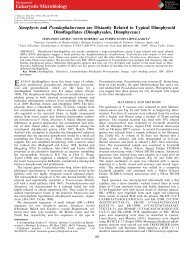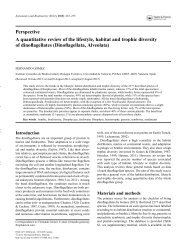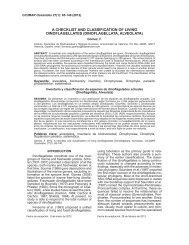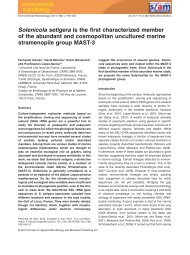The formation of the twin resting cysts in the dinoflagellate Dissodinium pseudolunula, a parasite of copepod eggs
The dinoflagellate Dissodinium pseudolunula is the most common and widespread ectoparasite of copepod eggs in neritic waters. When the host is absent, the species survives with a distinctive pair of twin resting cysts described as Pyrocystis margalefii. Based on live samples, the formation of the twin resting cysts is illustrated here for the first time. The gymnodinioid infective cells did not form overwintering cysts under unfavourable conditions. These are formed inside the secondary lunate sporangium
The dinoflagellate Dissodinium pseudolunula is the most common and widespread ectoparasite
of copepod eggs in neritic waters. When the host is absent, the species survives
with a distinctive pair of twin resting cysts described as Pyrocystis margalefii. Based
on live samples, the formation of the twin resting cysts is illustrated here for the first
time. The gymnodinioid infective cells did not form overwintering cysts under
unfavourable conditions. These are formed inside the secondary lunate sporangium
You also want an ePaper? Increase the reach of your titles
YUMPU automatically turns print PDFs into web optimized ePapers that Google loves.
F. GÓMEZ AND L. F. ARTIGAS j LIFE CYCLE OF DISSODINIUM, PARASITE OF COPEPOD EGGS<br />
egg. A host <strong>in</strong>fection could provide 8 lunate sporangia and<br />
<strong>the</strong> subsequent 8 pairs (16 cells) <strong>of</strong> <strong>rest<strong>in</strong>g</strong> <strong>cysts</strong>. Drebes<br />
(Drebes, 1981) observed that <strong>the</strong> cells that germ<strong>in</strong>ated to<br />
form <strong>the</strong> <strong>tw<strong>in</strong></strong> <strong>rest<strong>in</strong>g</strong> <strong>cysts</strong> were eventually able to divide.<br />
This may be <strong>the</strong> case <strong>in</strong> <strong>the</strong> specimens illustrated <strong>in</strong> Fig. 2S–<br />
T. Consequently, each <strong>in</strong>fected egg may provide 32 new <strong>in</strong>fective<br />
d<strong>in</strong>ospores for <strong>the</strong> follow<strong>in</strong>g spr<strong>in</strong>g (Figs 1 and 2).<br />
Intuitively, one might suggest that <strong>the</strong> factor that triggers<br />
<strong>the</strong> <strong>formation</strong> <strong>of</strong> <strong>the</strong> <strong>tw<strong>in</strong></strong> <strong>rest<strong>in</strong>g</strong> <strong>cysts</strong> is <strong>the</strong> absence <strong>of</strong><br />
<strong>copepod</strong> <strong>eggs</strong>. However, <strong>the</strong> secondary lunate sporangium<br />
may be unable to directly sense <strong>the</strong> presence <strong>of</strong> hosts <strong>in</strong><br />
<strong>the</strong> surround<strong>in</strong>g waters. It is uncerta<strong>in</strong> whe<strong>the</strong>r <strong>the</strong> decrease<br />
<strong>in</strong> <strong>the</strong> size or quality <strong>of</strong> <strong>the</strong> <strong>eggs</strong> <strong>in</strong>duces <strong>the</strong> <strong>formation</strong><br />
<strong>of</strong> <strong>the</strong> <strong>rest<strong>in</strong>g</strong> <strong>cysts</strong> as a mechanism to avoid <strong>the</strong> failure<br />
<strong>of</strong> <strong>the</strong> next generation <strong>of</strong> <strong>in</strong>fective d<strong>in</strong>ospores. Ano<strong>the</strong>r possibilitywouldbethat<strong>the</strong><strong>tw<strong>in</strong></strong><strong>rest<strong>in</strong>g</strong>cystisproducedata<br />
constant rate throughout <strong>the</strong> year, <strong>in</strong> order to provide a permanent<br />
seed<strong>in</strong>g bank. However, <strong>the</strong> active Dissod<strong>in</strong>ium form<br />
is common <strong>in</strong> April and May, while <strong>the</strong> <strong>rest<strong>in</strong>g</strong> <strong>cysts</strong> were<br />
ma<strong>in</strong>ly observed <strong>in</strong> July–September (John and Reid,<br />
1983). <strong>The</strong> <strong>tw<strong>in</strong></strong> <strong>rest<strong>in</strong>g</strong> <strong>cysts</strong> are preferentially formed <strong>in</strong><br />
<strong>the</strong> host-free season.<br />
This study provides new <strong>in</strong>sights <strong>in</strong>to <strong>the</strong> life strategies<br />
<strong>of</strong> this important <strong>parasite</strong> group (Fig. 3). <strong>The</strong> production<br />
<strong>of</strong> <strong>cysts</strong> has been reported <strong>in</strong> <strong>parasite</strong>s <strong>of</strong> t<strong>in</strong>t<strong>in</strong>nid ciliates<br />
(Coats et al., 2010). However, we know little about <strong>the</strong> overw<strong>in</strong>ter<strong>in</strong>g<br />
<strong>cysts</strong> <strong>in</strong> parasitic d<strong>in</strong><strong>of</strong>lagellates. Dissod<strong>in</strong>ium and<br />
o<strong>the</strong>r <strong>parasite</strong>s on <strong>copepod</strong> <strong>eggs</strong> may be a contributory<br />
factor to <strong>the</strong> large year-to-year variability <strong>in</strong> <strong>the</strong> stand<strong>in</strong>g<br />
stock <strong>of</strong> <strong>copepod</strong>s. It is important to understand <strong>the</strong>ir life<br />
cycles as a first step and to <strong>in</strong>clude parasitism <strong>in</strong> <strong>the</strong><br />
models <strong>of</strong> secondary production <strong>in</strong> <strong>the</strong> ocean.<br />
S U P P L E ME N TA RY DATA<br />
Supplementary data can be found onl<strong>in</strong>e at http://plankt.oxfordjournals.org.<br />
ACKNOWLEDGEMENTS<br />
We thank <strong>the</strong> crew <strong>of</strong> <strong>the</strong> R/V Sepia II (INSU) and UMR<br />
LOG technicians and students for <strong>the</strong>ir help <strong>in</strong> <strong>the</strong> field<br />
sampl<strong>in</strong>g <strong>of</strong> <strong>the</strong> Wimereux-Slack transect, which was part<br />
<strong>of</strong> <strong>the</strong> weekly monitor<strong>in</strong>g supported by <strong>the</strong> INTERREG<br />
IVA “2 Seas” DYMAPHY project, co-funded by E.R.D.F.<br />
funds.<br />
FUNDING<br />
F.G. was supported by a UL1 post-doctoral grant and a<br />
CNRS convention <strong>of</strong> research on phytoplankton. F.G. is<br />
currently supported by <strong>the</strong> Brazilian contract BJT 370646/<br />
2013-14 <strong>of</strong> Conselho Nacional de Desenvolvimento<br />
Científico e Tecnológico.<br />
REFERENCES<br />
Cachon, J. and Cachon, M. (1987) Parasitic d<strong>in</strong><strong>of</strong>lagellates. In Taylor,<br />
F. J. R. (ed.), <strong>The</strong> Biology <strong>of</strong> D<strong>in</strong><strong>of</strong>lagellates. Blackwell, Oxford, pp.<br />
571–610.<br />
Coats, D. W. (1999) Parasitic life styles <strong>of</strong> mar<strong>in</strong>e d<strong>in</strong><strong>of</strong>lagellates.<br />
J. Eukaryot. Microbiol., 46, 402–409.<br />
Coats,D.W.,Kim,S.,Bachvar<strong>of</strong>f,T.R.et al. (2010) T<strong>in</strong>t<strong>in</strong>nophagus acutus<br />
n. g., n. sp. (Phylum D<strong>in</strong><strong>of</strong>lagellata), an ecto<strong>parasite</strong> <strong>of</strong> <strong>the</strong> ciliate<br />
T<strong>in</strong>t<strong>in</strong>nopsis cyl<strong>in</strong>drica Daday 1887, and its relationship to Duboscquod<strong>in</strong>ium<br />
coll<strong>in</strong>i Grassé 1952. J. Eukaryot. Microbiol., 57, 468–482.<br />
Drebes, G. (1978) Dissod<strong>in</strong>ium <strong>pseudolunula</strong> (D<strong>in</strong>ophyta), a <strong>parasite</strong> on<br />
<strong>copepod</strong> <strong>eggs</strong>. Br. Phycol. J., 13, 319–327.<br />
Drebes, G. (1981) Possible <strong>rest<strong>in</strong>g</strong> spores <strong>of</strong> Dissod<strong>in</strong>ium <strong>pseudolunula</strong><br />
(D<strong>in</strong>ophyta) and <strong>the</strong>ir relation to o<strong>the</strong>r taxa. Br. Phycol. J., 16, 207–215.<br />
Drebes, G. (1984) Life cycle and host specificity <strong>of</strong> mar<strong>in</strong>e parasitic<br />
d<strong>in</strong>ophytes. Helgoländer Meeresunters., 37, 603–622.<br />
Gómez, F., López-García, P. and Moreira, D. (2011) Molecular phylogeny<br />
<strong>of</strong> <strong>the</strong> sand-dwell<strong>in</strong>g d<strong>in</strong><strong>of</strong>lagellates Amphid<strong>in</strong>iopsis hirsuta and A. swedmarkii<br />
(Perid<strong>in</strong>iales, D<strong>in</strong>ophyceae). Acta Protozool., 50, 255–262.<br />
Gómez, F., Moreira, D. and López-García, P. (2009) Life cycle and molecular<br />
phylogeny <strong>of</strong> <strong>the</strong> d<strong>in</strong><strong>of</strong>lagellates Chytriod<strong>in</strong>ium and Dissod<strong>in</strong>ium,<br />
ecto<strong>parasite</strong>s <strong>of</strong> <strong>copepod</strong> <strong>eggs</strong>. Eur. J. Protistol., 45, 260–270.<br />
John, A. W. G. and Reid, P. C. (1983) Possible <strong>rest<strong>in</strong>g</strong> <strong>cysts</strong> <strong>of</strong> Dissod<strong>in</strong>ium<br />
<strong>pseudolunula</strong> Swift ex Elbrächter et Drebes <strong>in</strong> <strong>the</strong> Nor<strong>the</strong>ast Atlantic<br />
and <strong>the</strong> North Sea. Br. Phycol. J., 18, 61–66.<br />
Mauchl<strong>in</strong>e, J. (1998) <strong>The</strong> biology <strong>of</strong> calanoid <strong>copepod</strong>s. Adv. Mar. Biol.,<br />
33, 1–710.<br />
Pouchet, G. (1885) Nouvelle contribution à l’histoire des Périd<strong>in</strong>iens<br />
mar<strong>in</strong>s. J. Anat. Physiol., 21, 28–88.<br />
Théodoridès, J. (1989) Parasitology <strong>of</strong> mar<strong>in</strong>e zooplankton. Adv. Mar.<br />
Biol., 25, 117–177.<br />
1171



